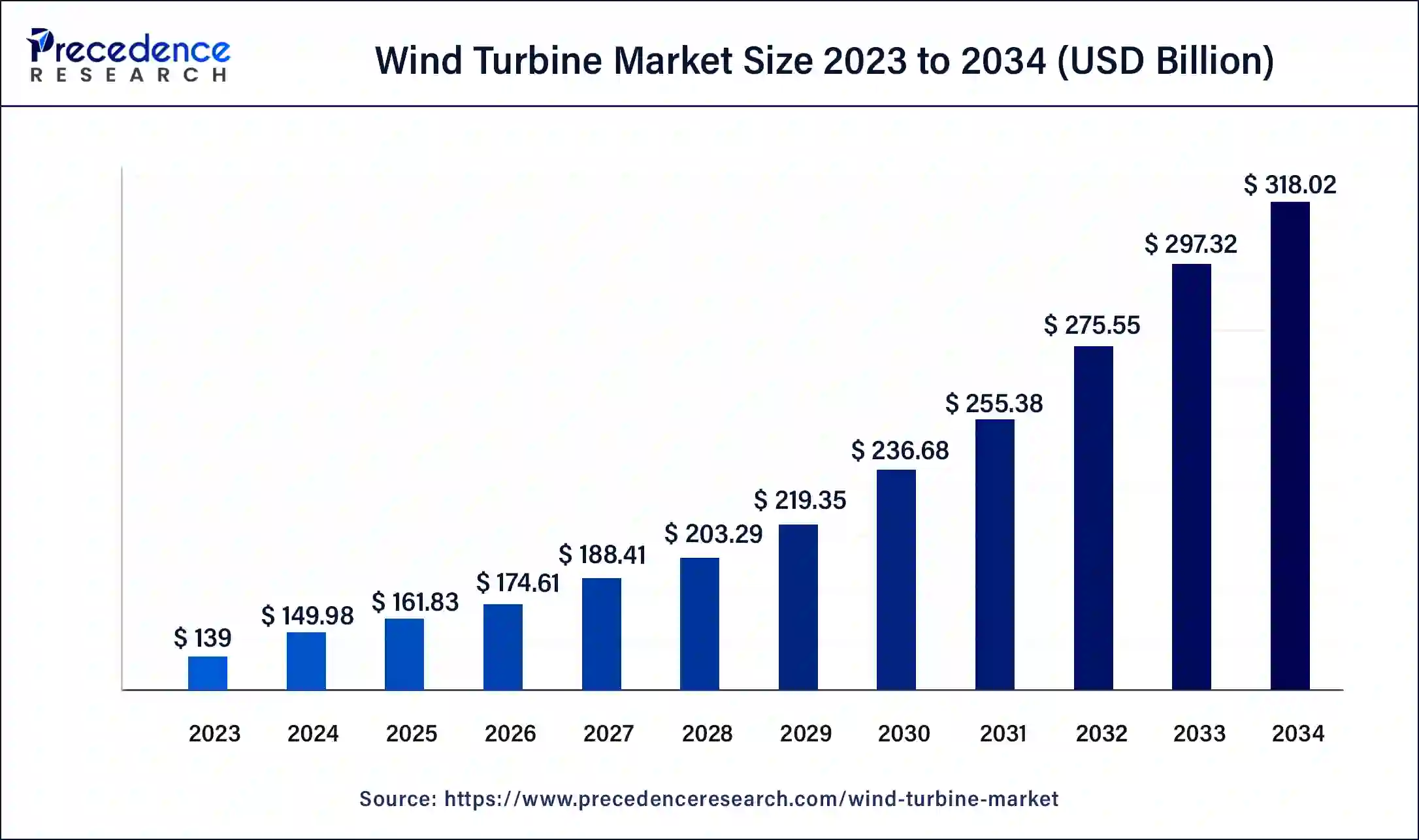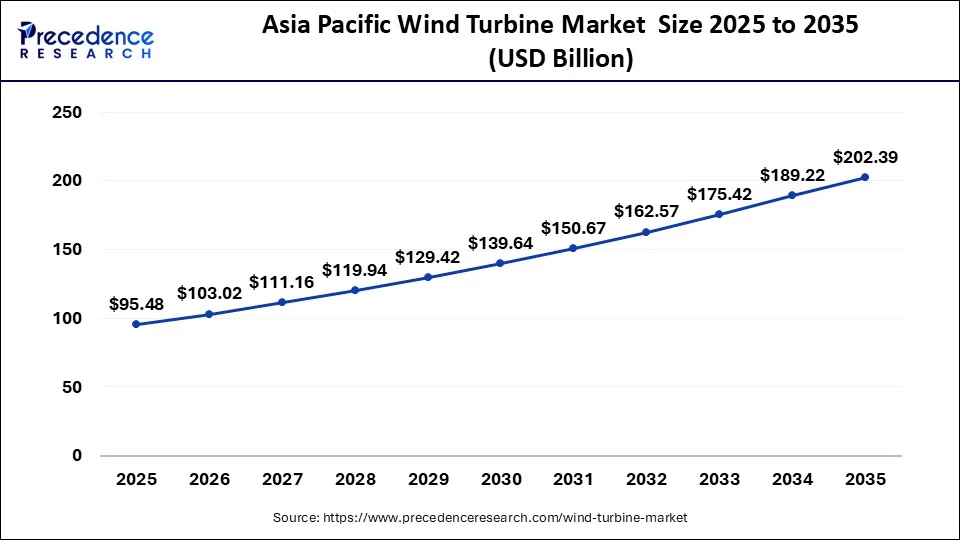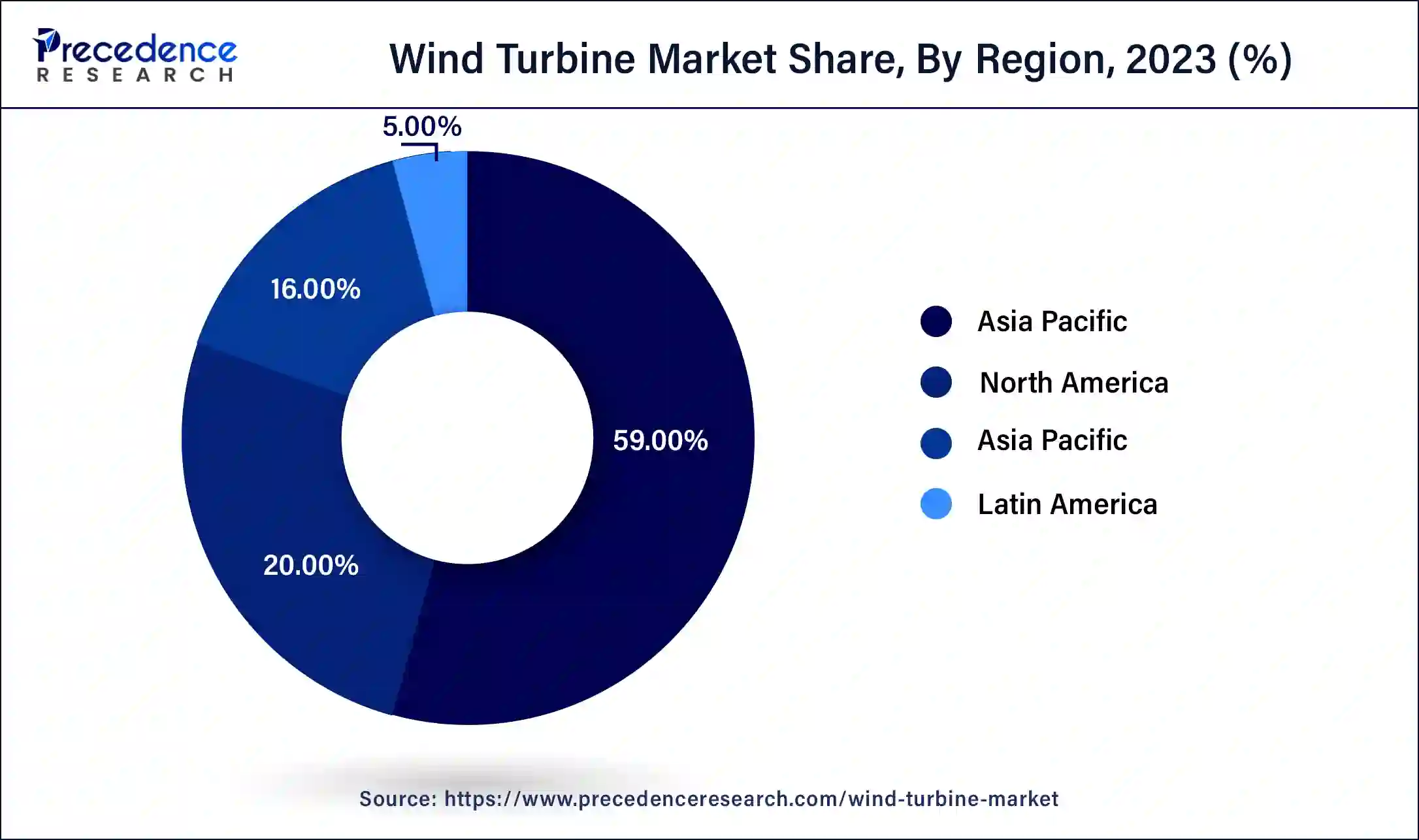List of Contents
What is the Wind Turbine Market Size?
The global wind turbine market size is calculated at USD 161.83 billion in 2025 and is predicted to increase from USD 174.61 billion in 2026 to approximately USD 339.43 billion by 2035, expanding at a CAGR of 7.69% from 2026 to 2035.

Wind Turbine Market Key Takeaways
- In terms of revenue, the wind turbine market is valued at $161.83 billion in 2025.
- It is projected to reach $318.02 billion by 2035.
- The wind turbine market is expected to grow at a CAGR of 7.69% from 2026 to 2035.
- Asia Pacific dominated the wind turbine market with the highest market share of 59% in 2025.
- By installation, the onshore segment dominated the global market in 2025.
- By componentse, the rotator blade segment held the largest share of the market in 2025.
- By application , the utility segment dominated the global market in 2025.
Market Overview
In order to convert the wind energy into electric energy, wind turbines are used in the wind power plants. The electric energy is derived due to the aerodynamic force of the rotor blades. The conversion of the aerodynamic force to the rotation of a generator produces electricity. As various governments are adopting initiatives to combat the climate change renewable energy is experiencing great growth. With the COVID-19 outbreak in 2020, the growth of the wind turbine market was impacted in terms of delays in manufacturing and delays in the supply of raw material or the supply of new turbines. So all of these were the challenges faced by the wind turbine market.
COVID-19 had impacted almost all the industries across the globe. The industrial operations were affected due to delays in the supply chains. The operations of many companies were halted due to the absence of workforce. Apart from that many vendors have migrated to their hometowns due to the uncertainties in the income during the lockdown so the production and manufacturing activities had come to an halt. Even during the forecasted the growth could be hampered due to the shortage of workforce. The import and export activities were also impacted which directly affected the wind turbines market.
Wind Turbine Market Growth Factors
As the governments are taking initiatives to produce renewable energy there is a growth in the market. An increasing demand for renewable energy sources, especially the wind power and efforts to reduce the dependence on fossil fuel based power generation are expected to be the major factors for the rise of this market. Many tax benefits and incentives are provided by the governments which are helping in reducing the prices of the components so it is expected to give a boost to the wind turbine market. Across many developing nations, there is a mismatch in the supply and demand so there is a surge in the wind turbine market.
In the offshore installation of the wind turbines, the companies are being able to install taller turbines and also larger blades in order to sweep more area than the smaller turbines. As the size of the wind turbines has grown, it has also helped in lowering the cost of wind energy. The adoption of offshore wind markets for the wind energy with the help of advanced technologies has attracted many nations and companies for high investments. The wind energy is variable. If the wind doesn't flow, no electricity is generated. The wind energy industry is still blooming due to the efforts taken by the various nations across the world to combat climate change, such as the Paris Agreement.
Trends in Wind Turbine Market
The global wind turbine marketplace continues to grow rapidly because there continues to be an increased global demand for environmentally friendly alternatives to hard-to-find and increasing expensive domestic oil supplies, continued growing government support towards growing interest for the development of new clean energy sources, dramatic advancements in wind turbine performance due to technological advancements, and increased use of both onshore (i.e., on land) and offshore (i.e., off shore) wind farm installation projects by many countries where financial opportunities exist for the projects' developers/investors.
- Growing demand for renewable energy sources like wind energy and a shift towards clean energy usage while reducing the use of fossil fuel is a growing trend in the market.
- Technological advancement to increase energy efficiency and energy production, reducing cost, drives the growth.
- Government initiatives and investments for the use of renewable energy sources while preserving the natural resources raise the demand and adoption.
- Rising focus on sustainability and efforts put together to combat climate change, and improvement in air quality, drive the growth.
- The global demand from all regions due to rapid expansion and advanced control systems supports the growth of the market.
Market Outlook
- Industry Growth Overview: The wind turbine industry has a strong growth outlook due to increasing global energy demand coupled with ambitious renewable energy targets. Offshore and larger wind turbine manufacturing will be the primary growth catalysts over the coming years,
- Sustainability Trends: Sustainability will be the main catalyst for growth within the wind turbine sector. Manufacturers are developing fully recyclable wind turbine blades, reducing lifecycle emissions throughout the wind turbine environment, and establishing sustainable manufacturing processes as part of their commitment to meet worldwide ESG goals.
- Global Expansion: Many countries in the emerging regions of Asia-Pacific (APAC), Latin America (LATAM), and Africa are rapidly increasing their wind energy production; this growth is supported by international development funding, cross-border partnerships, and a stronger transmission grid.
- Startup Ecosystem: A robust startup ecosystem exists in the wind energy industry where a growing number of startups are innovating with smart turbines, advanced data-driven performance analysis (AI-based), and innovative storage integration (e.g. battery storage and fuel cells), all of which are improving the overall efficiency of wind energy and changing the competitive dynamics of the wind energy marketplace.
Market Scope
| Report Coverage | Details |
| Market Size in 2025 | USD 161.83 Billion |
| Market Size in 2026 | USD 174.71 Billion |
| Market Size by 2035 | USD 339.43 Billion |
| Growth Rate from 2026 to 2035 | CAGR of 7.69% |
| Largest Market | Asia Pacific |
| Base Year | 2025 |
| Forecast Period | 2026 to 2035 |
| Segments Covered | Axis, Installation, Components, Application, Capacity, Connectivity, Rating, Region |
| Regions Covered | North America, Europe, Asia Pacific, Latin America, Middle East & Africa (MEA) |
Segment Insights
Axis Insights
Depending upon the axis of the wind turbine, the vertical segment is expected to dominate the global market and to remain the fastest growing segment in the forecast period as the main features of this type is it provides high efficiency at lower price.
Installation Insights
On the basis of the installation, the global wind turbine market can be classified into either onshore market or the offshore market. Onshore market has been on the high till 2024 and it is projected to remain the fastest growing segment even during the forecast period. The onshore wind market is expected to grow rapidly during the forecast period owing to the factors like higher demand for the onshore installation as compared to the offshore installation.
The offshore wind turbine installation is expected to grow during the forecast as the major companies in the countries are turning towards the adoption of renewable energy sources and clean energy sources. The offshore wind turbine provides many other benefits like improved power generation due to consistent wind flow and quick installation of the turbines.
Components Insights
The wind turbine market has many components and based on the components it can be classified into rotator blade, Generator, gearbox, nacelle and others. The rotator blade segment has dominated the market till 2024 and it shall rise during the forecast the reason being rapid industrialization and increased power industries.
Application Insights
The various applications of the wind turbines are industrial applications, commercial applications, utility and residential applications. The utility segment has dominated the market till date and it is expected to grow during the forecast as the Governments are making stringent policies in order to have sustainable renewable projects. Due to rapid urbanization and rapid expansion of local production the demand in the residential application is expected to rise.
Regional Insights
Asia Pacific Wind Turbine Market Size and Growth 2026 to 2035
The Asia Pacific wind turbine market size was valued at USD 95.48 billion in 2025 and is expected to be worth around USD 202.39 billion by 2035, at a CAGR of 7.80% from 2026 to 2035.

The Asia Pacific region is expected to be the largest and the fast paced market as they have the largest wind power generation and the presence of manufacturing and technological hubs in various countries like India, Japan and China. The installation capacity in China has dominated the Asia Pacific market. The fourth largest wind power installed capacity is held by India. The major projects are situated in the northern, western and the southern parts of the country. The Indian government aims to achieve 60 gigawatts, by the end of 2022. Major companies are investing in the Asia Pacific market.
China now dominates the wind turbine market in the Asia Pacific region, largely thanks to its renewable energy targets and investment in onshore and offshore wind developments. Specifically, China has installed more turbines than any other country, with full support from national policies like the 14th Five-Year Plan, which continues to support the transition to clean energy in tighter markets. Additionally, turbine manufacturers like Goldwind and MingYang are becoming more reputable nationwide and internationally. Rapid capital investment by many coastal provinces also appears to be increasing offshore wind capacity and installing large-scale generation to support energy demands as fast as possible, preserving China's leadership in global wind power scenarios.
In May 2025, China unveils world's largest offshore wind turbine with hub height of 185 meters. With a hub height of 185 meters (606 feet) – equivalent to a 63-story skyscraper – the single 26-megawatt (MW) turbine can potentially generate 100 million kilowatt hours (kWh) of renewable electricity each year.
(Source: https://www.iflscience.com)

North America is the biggest segment for this market in terms of region. It is due to the rapid infrastructure expansion and due to the implementation of various offshore wind projects the global wind turbine market has Asia Pacific region as the fastest growing area and it is expected to grow during the forecast. The main reasons for the growth in this region are the increasing population which provides a large consumer base and an ever increasing demand for the renewable sources of energy.
The United States is the leading country in the North American wind turbine market, due to strong federal tax credits, investments in renewable energy infrastructure, the Inflation Reduction Act of 2022, and commitment to an established energy transition roadmap. Wind corridors in states like Texas, Iowa, and Oklahoma have significant installed wind capacity, while the Inflation Reduction Act of 2022 has strengthened and expedited investment in not just renewable energy infrastructure, but advanced turbine technology and capabilities. U.S. manufacturers like GE Vernova and Vestas have dedicated long-standing management in the U.S. market and support large target (GW) advanced onshore and offshore wind projects. According to U.S. Wind Turbine Database, the USWTDB contains 76,051 turbines with a total rated capacity of 154,146 MW.
(Source:https://energy.usgs.gov)
All while information exchange, outcomes, and innovation continue to be leveraged into larger production and scaled outcomes for a transition away from fossil fuels into a more environmentally-friendly and sustainable energy landscape.
Europe Wind Turbine Market:
Europe continues to dominate the global wind industry with substantial commitments toward greater use of renewables and offshore wind developments. The countries of Germany, United Kingdom, Denmark and Spain lead the way with respect to innovation related to offshore wind turbine technology. They possess strong and supportive regulatory frameworks that support their ambitions to achieve net zero in the long term, and as a result, they consistently improve their wind turbine development capabilities. Moreover, the strong array of manufacturers located in Europe, combined with mature supply chains, gives Europe a definitive edge over all other regions where wind turbine technology is being developed.
Latin America Wind Turbine Market:
With the support of abundant wind resources and renewable energy-friendly policies, Latin America is getting increasingly attractive as a market for wind turbine development. Countries like Brazil, Chile, and Mexico are investing in building large-scale, high-capacity wind farms to meet the growing demand for electricity. Competitive auction structures being used to generate interest in new wind development coupled with a growing number of international companies investing in the region and improving grid infrastructure create additional momentum to accelerate the growth of wind power in Latin America. Wind energy also provides an energy security benefit, gives local residents good jobs, and supports sustainable economic growth within Latin America.
Value Chain Analysis
- Raw Material and Component Manufacturing: Raw materials include metals (such as steel), composite materials (like fiberglass), rare earth metals used in electronic components (including motors and batteries), control systems, etc., for nacelles, towers, and blades.
- Wind Turbine Assembly and Installation: The major players (Vestas, Siemens Gamesa, and GE) take over the turbines from component manufacturing and then execute logistics for getting to the assembly site, preparing the site, and executing installation of the turbine;
- Operation, Maintenance, and Services: The long-term operation of wind turbines includes a focus on maximizing the lifetime and energy production of the turbine. This entails digital monitoring, predictive maintenance, and other services for a turbine's long-term sustainability.
Wind Turbine Market Companies
- General Electric company.
- Vestas Wind Systems A/S
- Nordex SE.
- Suzlon Energy Limited.
- Siemens Gamesa renewable energy. SA
- CSIC.
- Shanghai Electric.
- Windey
Recent Developments
- In May 2025, ZF Wind Power launched India's largest 13.2MW test rig in Coimbatore. This modern test rig is used for comprehensive testing and validation of gearboxes and powertrains, ensuring they can withstand the rigorous demands of modern wind turbines. The dynamic testing capabilities, including real-time simulation of field conditions and torque reversal cycles, support extreme validation up to 20 MNm.
(Source: https://www.financialexpress.com) - In May 2025, Senvion India launched the 3.1 M130 wind turbine, and the installation will begin across the country. It is developed to enhance control systems and also site-specific flexibility. It is engineered to maximise annual energy production under Indian wind conditions.
(Source: https://renewablewatch.in) - In May 2025, Haventus and Sarens, the UK-based companies PSG, have developed a low-cost solution for the integration and launch of floating offshore wind turbines. The company said that the installations will be offshore and will also cut down the costs and accelerate floating offshore wind deployment.
(Source: https://www.offshorewind.biz) - In April 2025, Enel, a global leader in renewable energy, launched ‘WinDesign. The goal of this is to develop turbine projects that blend more effortlessly into the landscapes that host them, thereby supporting a wider role for them in the energy transition. (
Source: https://www.designboom.com) - GE Renewable Energy announced that they will be supplying 42 units of 2.7-132 onshore wind turbines for the wind projects, which will be a total of 110 megawatts in India , which will help in meeting the electricity demand of various industrial companies in the states of Gujarat as well as Karnataka during the forecast period.
- In 2021, GE Renewable Energy and Toshiba Energy solutions along with Solutions Corporation announced a partnership to localize the critical phases of the manufacturing of GE Haliade X which is an offshore wind turbine and support the commercialization of this turbine in Japan.
- JSW energy Ltd which is a part of JSW group has ordered 810 MW of onshore wind turbines from GE Renewable energy for its upcoming projects in Tamil Nadu.
Market Segmentation
By Axis
- Vertical
- Horizontal
By Installation
- Offshore
- Onshore
By Components
- Rotator blade
- Generator
- Gearbox
- Nacelle
By Application
- Residential
- Utility
- Industrial
- Commercial
By Capacity
- Small
- Medium
- Large
By Connectivity
- Grid Connected
- Stand Alone
By Rating
- < 100 kW
- 100 kW to 250 kW
- > 250 kW to 500 kW
- > 500 kW to 1 MW
- 1 MW to 2 MW
- >2 MW
By Geography
- North America
- Latin America
- Europe
- Asia-pacific
- Middle and East Africa
For inquiries regarding discounts, bulk purchases, or customization requests, please contact us at sales@precedenceresearch.com
Frequently Asked Questions
Tags
Ask For Sample
No cookie-cutter, only authentic analysis – take the 1st step to become a Precedence Research client



